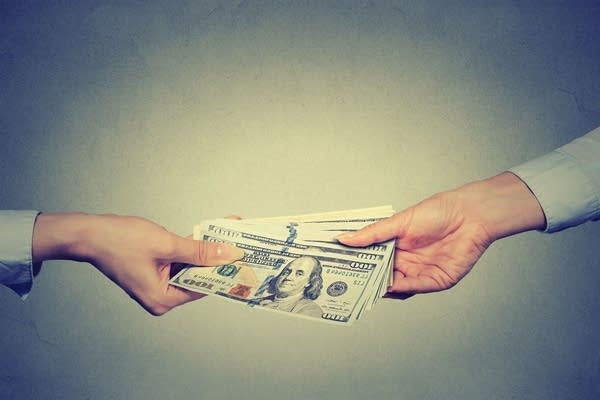Why do Americans tip when people in other countries don’t have to?
One expert credits America’s strong tip culture with weaker unions.

This is just one of the stories from our “I’ve Always Wondered” series, where we tackle all of your questions about the world of business, no matter how big or small. Ever wondered if recycling is worth it? Or how store brands stack up against name brands? Check out more from the series here.
Carole Salzwedel asks:
Why do Americans tip when other countries don’t?
If a tip screen appears at a self-checkout machine, and no one is there to collect it, does anyone get paid?
Tipping prompts have found their way into digital kiosks at airports, farmers’ markets, doggie daycares, convenience stores, sports stadiums, spas and gas stations, leaving customers confused about where their tips are going. All but ubiquitous, those prompts sometimes ask for as much as 30% on top of the purchase price.
Around the world, you might give a courtesy tip for good service, maybe a couple of bucks or as little as 5% of your bill. But tipping is deeply entrenched in U.S. culture.
“We tip more occupations than any other country, and we tend to tip larger amounts than other countries. We’re kind of the tip-happiest country out there,” said Michael Lynn, a tipping expert and professor of consumer behavior and marketing at Cornell University’s School of Hotel Administration.
Experts trace this very American tradition back to weaker unions, business owners who wanted to exploit the cheap labor of a changing workforce and a hotel culture that valued tips as it began to serve more a la carte meals.
Tipping originated in Europe, likely with house guests tipping their hosts’ servants starting around the 16th century, said Andrew Haley, a history professor at the University of Southern Mississippi and author of the book “Turning the Tables.”
Tipping in the U.S. took off after the Civil War, when dining out mostly happened at hotels. Rich, regular customers were served large roasts instead of made-to-order dishes. “So having a positive relationship with the waiter meant that you got the choice cuts of meat and things like that,” Haley said.
American tipping also has roots in slavery, according to some experts. The changing workforce in Reconstruction-era America helped give rise to tipping, Saru Jayaraman, president of the service worker advocacy group One Fair Wage, told “Marketplace Morning Report” last year.
“The restaurant industry started looking for cheaper labor, and after emancipation, they hit upon the idea of hiring newly freed Black people, “said Jayaraman, who’s also the director of the Food Labor Research Center at University of California, Berkeley. “Black women, in particular, coming up from the South. And telling them, ‘We’re not going to pay you, you’re going to exist on this thing that’s come from Europe called tips.'”
As more middle-class people began dining out in the late 19th century and early 20th century, tipping became controversial. Diners worried they were at a disadvantage and didn’t get the same quality of service compared to richer customers who could afford to tip, Haley said.
In the 1910s, some states banned tipping, but walked those laws back because they were difficult to enforce.
In Europe, restaurants began adding service charges to the bill around the 1920s, which helped reduce the need for tipping. Customers would sometimes see this service charge explicitly listed on the bill, especially in southern Europe. In some cases, restaurants would actually tell customers they didn’t need to tip, Haley said.
Why did this practice become successful in Europe? The answer’s tricky, Haley said.
Haley said he thinks it’s because Europe had a “stronger union tradition,” enabling them to negotiate higher wages and do away with tipping.
“Tipping in Europe is just viewed as the exception because waiters are being paid decent wages,” he said. After World War II, European countries also begin providing free health care and education, Haley added.
Then in the 1990s, many European countries passed minimum wage laws, which included servers, Haley said.
American employers only have to pay tipped employees $2.13 an hour if that amount, along with their tips, is at least equal to the federal minimum wage (which currently stands at $7.25 an hour), the employee is allowed to keep those tips, and the employee “regularly receives more than $30 a month in tips.” If their tips and direct wages don’t amount to at least $2.13, the employer is supposed to make up the difference. If state law diverges from federal law, then the employer will have to follow “the standard most protective to employees.”
One expert argues that the rise of tipping follows the transition of American meal plans at hotels, in which meals are included with the hotel room, to European meal plans, in which meals are sold separately, during the early 20th century.
“Managers were more amenable to tipping under the European Plan because they regarded it as a supplement to wages rather than as a bribe for giving away food,” wrote Marc Mentzer, author of the paper “The Payment of Gratuities by Customers in the United States,” and a professor of human resources and organizational behavior at the University of Saskatchewan.
During the Prohibition era, hotels turned their bars into lunch rooms where they sold a la carte meals, Mentzer wrote. Hotels had already been gradually moving away from the plan, but hotels that hadn’t already switched to the European meal plan did so to help with profits.
“Alcohol then, as now, has always been a high markup item for restaurants. So restaurant owners were in a desperate financial spot, because all alcoholic beverages were suddenly illegal. And so at that point, the idea of customers leaving extra money on the table for the server seemed like a wonderful idea to restaurant managers,” Mentzer said.
While consumers are encouraged to tip in the U.S., the practice is still polarizing and some consumers are bemoaning tipflation thanks to an increase in different businesses asking for tips and the rise of digital payment systems, which can ask for a high tip percentage.
Proponents of the tipping model say that the model can incentivize good service and allow servers to earn higher wages. And old habits die hard: restaurants and policymakers in the U.S. have struggled to eliminate tipping for all kinds of reasons: phasing out tipping can mean fewer workers, higher menu prices and service charges that confuse patrons.
But restaurants implementing a no-tipping policy can reduce pay disparities between servers and back-of-house workers like cooks and dishwashers.
“I’ve never met anyone who would go to their boss and say, ‘Pay me whatever you want to pay me — whatever you want to pay me, based on what you think the quality of my work was,’” the late economist William Spriggs told Marketplace in 2021.
In the 19th century, people critiqued tipping because it meant servers had to “pander for wages,” Haley said. It’s a critique that’s still relevant to this day.
“I think workers across the board should be paid a minimum wage and a higher minimum wage than we currently have, which is not a living wage,” Haley said. “You should not feel that when you’re in the restaurant that you are forced to pay the worker’s salary. It is a patronizing thing to do, to determine somebody’s salary based on one brief interaction. None of us would want our worst day to suddenly reduce our salary.”













